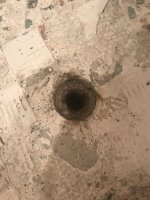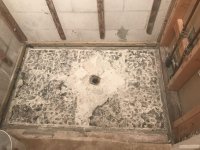There are numerous ways to construct a viable, long-lasting shower pan. All of them require a waterproof layer (neither tile nor grout are considered waterproofing). If there was a liner in your existing pan, it's destroyed now. Code calls for it to extend at least 2" above the top of the curb without any penetrations (so in effect, it must be taller to then attach to the walls and not have holes in it).
So, assuming that's a clamping drain, (I can't tell for sure with your pictures), AND, that you can get the center adjustable portion to move (probably not), yes, you could reuse the drain.
Your best bet is to remove the shower pan, expose the drain and see exactly what you have. Then, you need to decide on the method of shower construction you want to do. Building a reliable shower isn't technically hard, but it is VERY detail oriented. You need to choose your method and follow through. My preference is to use a more modern method than the conventional pvc liner. Using one of those methods means that the entire shower becomes waterproof (instead of just the pan), and that waterproofing is immediately beneath the tile rather than being buried. NOte, while the block walls won't be damaged by being wetted, they are NOT waterproof. Plumbing code specifies that the waterproofing in a shower must be sloped to the drain at a pitch of NLT 1/4"/foot, so putting it flat on the floor may not leak, but it doesn't meet code. NOw, some places only look at does it leak. I think they're either lazy, or don't understand the ramifications.
www.johnbridge.com specializes in building things out of tile and has a bunch of pros that moderate and contribute (along with DIY'ers).



